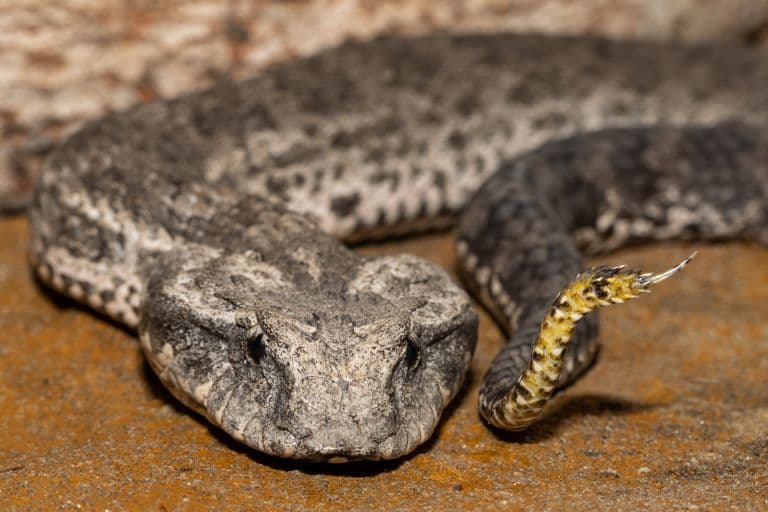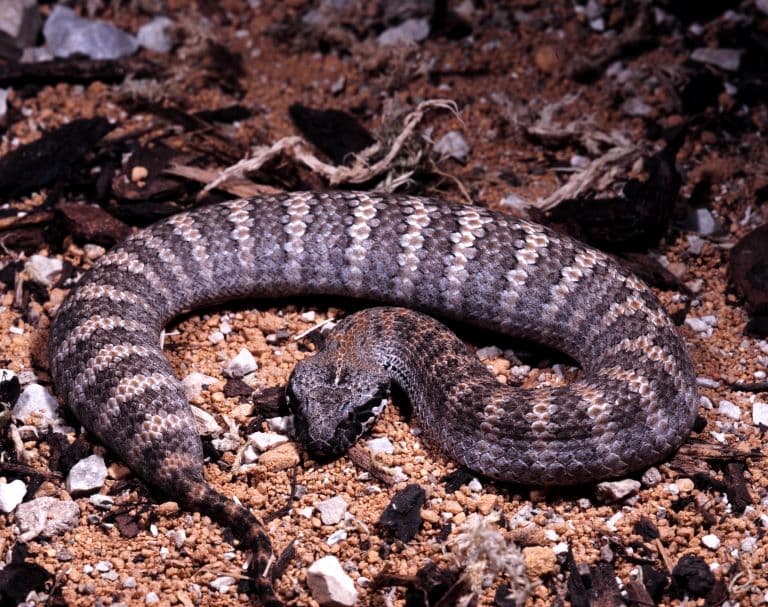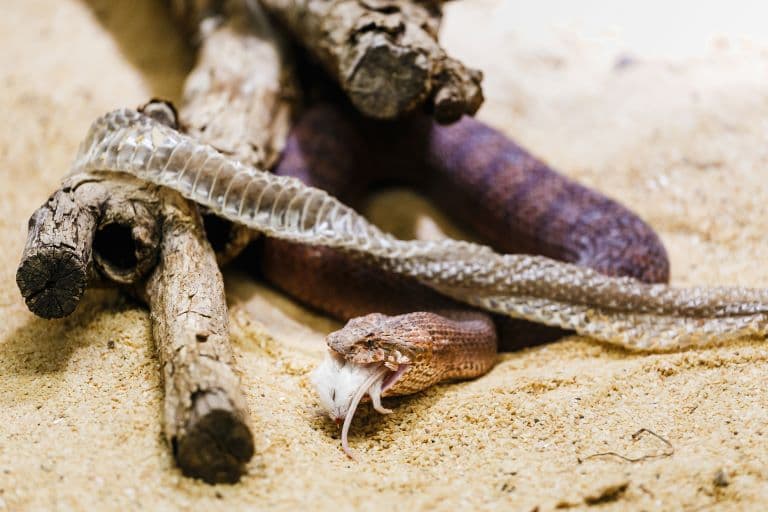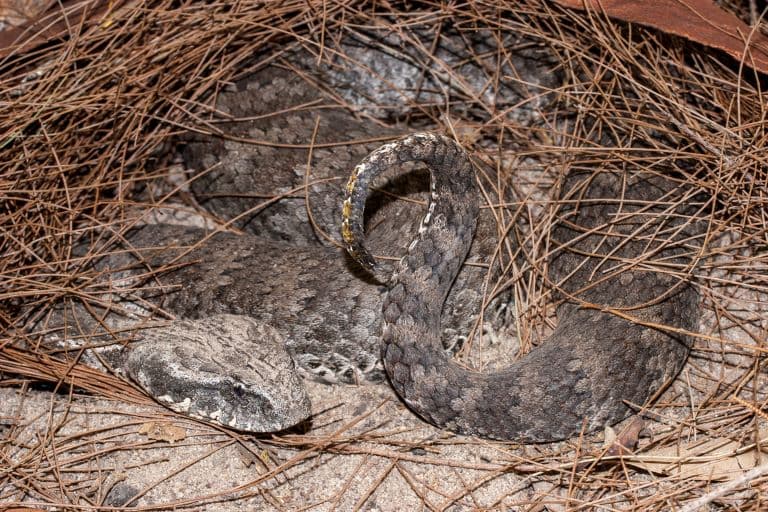Common Death Adder Profile
To the rest of the world, Australia is synonymous with venomous snakes, and this causes so much facepalming around the office of Australian ecologists that they hardly have time to get anything else done.
There are around 170 species of snake on the Island, and only around 12 are truly scary. For reference, there are far more in South Africa, which is where all the deadly Australian snakes came from, anyway.
So, when you come across the name “Death Adder” you might assume that the name is a bit hyperbolic. Unfortunately, though, in this case, it very much isn’t.

Common Death Adder Facts Overview
| Habitat: | Rainforests to shrublands and heaths |
| Location: | Southern and Eastern Australia |
| Lifespan: | Possibly more than 15 years |
| Size: | Usually around 60cm (2 ft), sometimes up to 1m (3 ft long) |
| Weight: | Up to 1.5 kg (3.3 lb) |
| Colour: | Leafy brown to dark grey or black with bands of alternating light and dark |
| Diet: | Small mammals and birds |
| Predators: | Large lizards, kookaburras |
| Top Speed: | Mostly slow, some of the fastest strike speeds |
| No. of Species: | 1 |
| Conservation Status: | Least Concern (IUCN) |
When venomous snakes arrived in Australia, they spread into all sorts of available niches, including those traditionally filled with vipers in other parts of the world.
Since the environment carves animals into what they are, snakes filling the viper niches turned out to look like vipers, and so the common death adder, an elapid snake, developed distinctly viper-like features.
They’re stocky, long-fanged and fast animals, and carry a serious amount of venom. Sadly, they’re in decline due to the impact of an infamous amphibian.
Interesting Common Death Adder Facts
1. They’re not adders
Adders are members of the Viper family. Vipers are generally short, stocky, venomous and fast, with a wide, triangular head – all of which apply to the death adder, yet arose independently from the vipers through a process of convergent evolution.
The common death adder, along with its friends the suspicious death adder and the slow and painful death adder, make up a genus of Elapid snakes: this is the family that contains the cobras, mambas and coral snakes and lots of other terrifying individuals.
So, this is a family of highly venomous snakes and one from which all venomous snakes in Australia descend. In fact, there are no viper species in Aus at all, since there were only pythons around when the elapids showed up, and the latter took all the available niches.
There are at least 11 species of death adders, and they’re all very viper-like in appearance, hence the name. They even have longer fangs than most elapids and behave a lot more like vipers in many ways. One classically viper-like characteristic is striking speed.

2. They’re “Deaf”
The lightning-fast speed of this elapid is what allows its incredible success in hunting as an ambush predator.
These snakes will, however, not strike until the perfect moment, and are in general considered hesitant to bite unless something is literally under their nose.
This might explain why they were originally named “Deaf adders”, and while the current name might be a bastardisation, it’s still pretty accurate. 1
3. They’re fast
These are stocky snakes, like many vipers are (despite being elapids), and they don’t tend to move all that much. When they do go from one place to another, it’s at a leisurely pace, though they prefer not to move at all.
These snakes can lie in wait for several days without moving, only changing pace when food walks right up to them.
And when that happens, they accelerate from some of the slowest animals to one of the fastest. A strike from one of these snakes can be over in less than 0.15 of a second, and this species is likely the fastest of them all. 2

4. They’re highly venomous
Sitting beneath the leaf litter, the only parts of the snake that are visible are the head and the tail. The tail can be wiggled enticingly, bringing animals who like to eat worms dangerously close to the sharp end.
And when that happens, up to 100mg of incredibly toxic elapid venom can be injected; enough to kill a person in about 50% of cases – a rate which was upheld until antivenom was developed around the ‘50s.
Thankfully, this venom doesn’t spread all that fast, so as long as a person can get to a hospital, the prognosis is relatively good.

5. They give birth to live young
Another way these weird snakes differ from most is how they reproduce. Vipers are the only snakes commonly known to produce live offspring, and it seems this elapid has evolved to mimic even this element of viper life.
Death adders are viviparous and produce a live litter of between 3 and 30 adderlets, ready to go out of the box. 3
6. Cane toads are messing them up
One of the most devastating mistakes to occur in Australian history was the introduction of cane toads.
Sugar cane had been introduced to the island from South Africa in the late 1700s, and began to explode with the tireless contribution of native slaves. But it was around the 1930s when the native cane beetle, a common pest of the sugar cane, was finally met with a potential solution.
Cane toads were brought over from Hawaii after their success as a biocontrol in their native lands was recognised by the sugar farmers. It seemed like a good idea at the time, but what the farmers didn’t know is that cane beetles are about the only thing a cane toad doesn’t want to eat.
What ensued was one of the largest ecological disasters in the history of agriculture and one that continues to this day. Cane toads are not only voracious predators, but they are also highly toxic, so they wipe things out at both ends of the spectrum.
Native predators, like the common death adder, didn’t evolve in the presence of toxic frogs, so have no instinct to avoid them, and will become poisoned by cane toads if large enough, and swallowed by them if they’re still little.
So, the common death adder is in steep decline, along with a plethora of other native species devastated by this toad. Still, it hasn’t reached the point of concern yet, according to the IUCN, though it was last assessed in 2017. 4
Common Death Adder Fact-File Summary
Scientific Classification
| Kingdom: | Animalia |
| Phylum: | Chordata |
| Class: | Reptilia |
| Order: | Squamata |
| Family: | Elapidae |
| Genus: | Acanthophis |
| Species: | antarcticus |
Fact Sources & References
- Made in the Wild (2019), “Fastest Strike on the Planet! Ft. Death Adder”, YouTube.
- Snake Charmer (2013), “Acanthophis hawkei Slow Motion Strike and Feeding”, YouTube.
- “Common Death Adder”, Australian Reptile Park.
- B. L. Phillips (2010), “Predator behaviour and morphology mediates the impact of an invasive species: cane toads and death adders in Australia”, Zoological Society of London.
